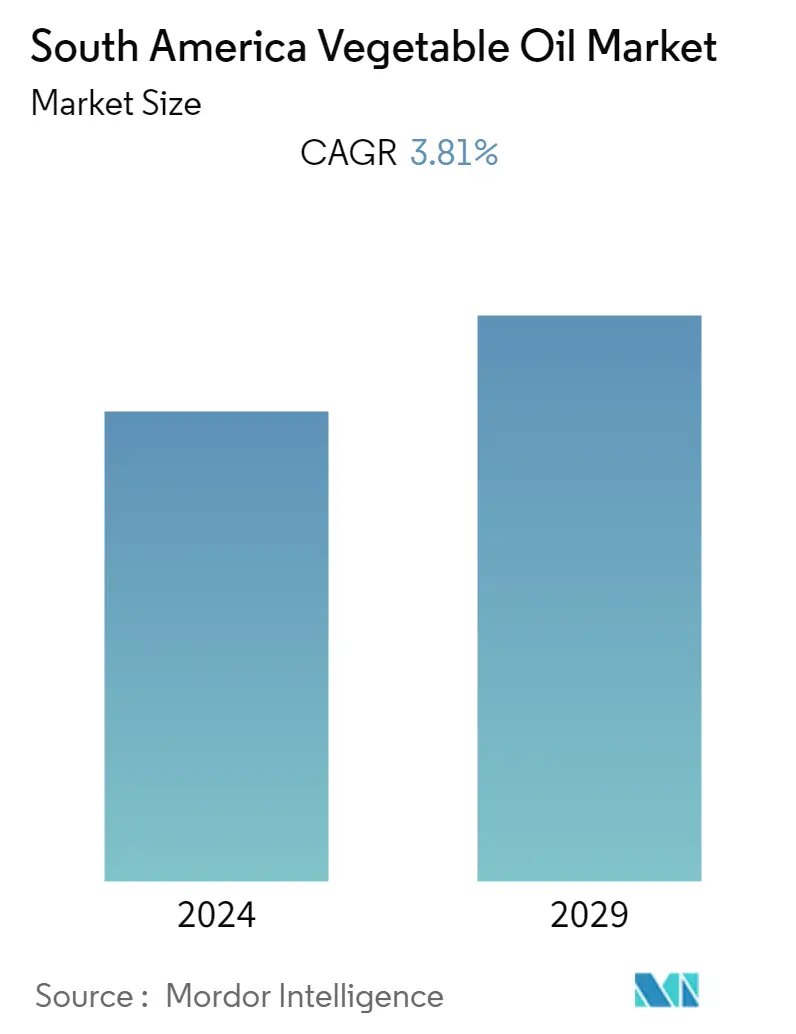Market Size of South America Vegetable Oil Industry

| Study Period | 2019 - 2029 |
| Base Year For Estimation | 2023 |
| Forecast Data Period | 2024 - 2029 |
| Historical Data Period | 2019 - 2022 |
| CAGR | 3.81 % |
| Market Concentration | Low |
Major Players.webp)
*Disclaimer: Major Players sorted in no particular order |
Need a report that reflects how COVID-19 has impacted this market and its growth?
South America Vegetable Oil Market Analysis
The South America vegetable oil market was valued at 18,963.45 thousand tons for the current year and is projected to register a CAGR of 3.81% over the next five years.
- South American countries, such as Brazil and Argentina, are the major exporters of peanut oil. Brazil and Venezuela are the leading vegetable oil-producing countries in South America. Amplifying demand for healthy edible oils obtained from natural sources is propelling the growth of the vegetable oils market. The growing processed food industry of the region, coupled with the growth of the food service industry, is further expected to aid the market growth of vegetable oils in South America.
- Moreover, the growing consumer emphasis on health and wellness in the region further boosts the demand for olive oil. Olive oil is not only used as a dressing but also as a cooking aid, making it a preferred choice among health-conscious individuals. The rising demand is met by imported olive oil in the region. According to the United States Department of Agriculture (USDA) Foreign Agricultural Service, Brazil imported 120,000 metric tons of olive oil in 2021, majorly from Portugal, Spain, Argentina, and other global countries.
- Similarly, as the population in South America continues to grow, so does the demand for edible oils. Vegetable oils, which are used for cooking and frying as well as being a component of many processed foods, are a significant source of calories and fat in the diet of South America. Vegetable oils are generally considered healthier than animal fats, as they are lower in saturated fat and higher in unsaturated fat. This has led to a growing awareness of the health benefits of vegetable oils among consumers, increasing demand. Moreover, vegetable oils are utilized in creating biofuels, which are becoming increasingly popular as a more environmentally friendly substitute for fossil fuels. This has helped to create an additional market for vegetable oils, driving further growth in the industry.
- South America has a favorable climate for growing oilseed crops such as soybeans and sunflowers, which are the primary sources of vegetable oils in the region. This has led to high yields and lower production costs, making South American vegetable oils more competitive in the global market, thus supporting the market's growth. Sunflower and soybean are the major oils consumed and produced in Argentina. According to a USDA report, in 2020-2021, Argentina produced 2,900 and 48,000 thousand metric tons of sunflower and soybean, respectively.
